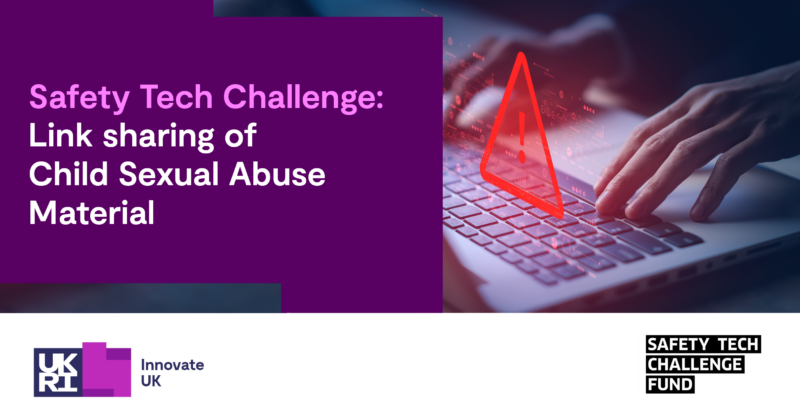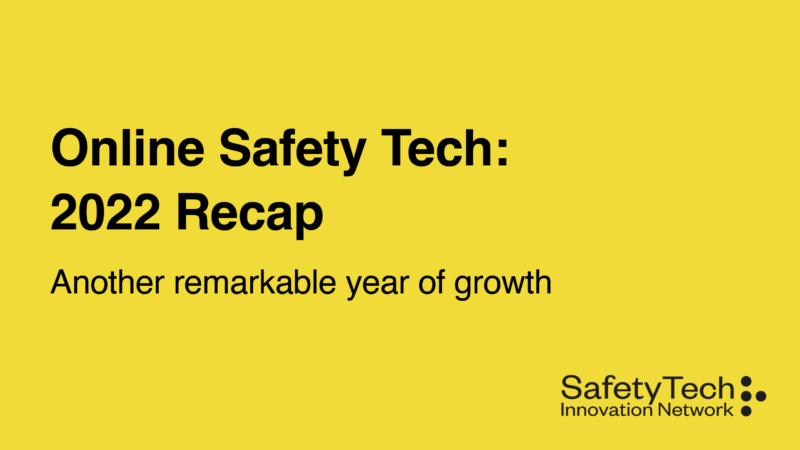Safety Tech 2021: Insights from the world’s first safety tech expo
In March 2021, the safety tech industry convened for the world’s first expo dedicated to the sector and discussed how the industry can achieve its mission of creating a safer internet for all.
Over 30 industry-leading speakers shared actionable steps that companies can take to protect both their users and their workers from online harms, with an audience of over 500 tuning in for the virtual expo.
Each session was tailored to a different challenge faced by the safety tech industry and can be watched below; full transcripts are also available for each session, which can be found below.
Unleashing the potential for a safer internet
Session speakers included:
- Suki Fuller, Founder and Analytical Storyteller, Miribure
- Clara Tsao, US Presidential Innovation Fellow and Founder, Trust and Safety Professional Association
- Julie Cordua, CEO, Thorn
- Oliver Dowden MP, UK Secretary of State, The Department for Digital, Culture, Media and Sport (DCMS)
- Rishad Tobaccowalla, Author of ‘Restoring the Soul of Business: Staying Human in the Age of Data’
- Marc Antoine Durrand, COO, Yubo
- Rachael Franklin, Senior Vice President of Positive Play, EA
- Weszt Hart, Head of Player Dynamics, Riot Games
Attendees listened to topics ranging from how technology can be used to create value for brands, to how to address toxic content and behaviours, and how safety tech can help companies in an age of immersive entertainment.
Key messages included:
- The three lessons Clara Tsao has learned during her career:
- the safety tech community must learn how to collaborate at all times, not only when there is a crisis;
- companies must consider safety tech as a long-term return on investment; and
- we can only design the online culture we demand.
- Rishad Tobaccowala’s view that companies are able to navigate beyond toxic online behaviours by using the acronym S-A-V-E: society (think about people over consumers) – accelerate (don’t let problems fester) – values (make valued judgements) – errors (mistakes are okay).
- Julie Cordua’s three actions for child online safety:
- equip children with the skills to safely navigate the internet;
- build in protection tools so that children can navigate the internet safely; and,
- detect and remove abuse proactively.
Access the opening plenary transcript.
Resilience and wellness – solutions to moderate content online
Session speakers included:
- Erika Barros, Director of Policy, Vimeo
- Naheed Sheikh PsyD, Co-founder, The Workplace Wellness Project
- Justin Davis, CEO, Spectrum
- Chengos Lim, Head of Content Safety, Dropbox
- Caitlin Borgman, VP, Thorn
Delegates heard how organisations are using technology to empower human moderators, while protecting their online communities at scale:
- Chengos Lim and Erika Barros discussed the Turner Effect that Dropbox and Vimeo use to reduce their moderators’ exposure to harmful content. For example, the ability to automatically blur child sexual abuse imagery on screen and the option to view images in black and white; the less vibrant the image, the less likely it will be remembered.
- Naheed Sheikh PsyD explained that the most essential component of a wellness programme is to show respect for the teams who do the work. One way to do this is to change the language used to describe the work they undertake. For example, the term ‘content moderation’ neutralises the nature of the work and reduces the urgency that is essential in bringing resources to it, however, using terms like ‘digital first responders’ gives the work gravitas and the respect it needs.
Access the resilience and wellness breakout session transcript.
User safety and your enterprise architecture
Session speakers included:
- Remy Malan, VP Trust & Safety, Roblox
- Chris Priebe, Founder and Executive Chairman, Two Hat
- Emma Rosell, CTO, NetClean
- Michele Banko, CTO, Sentropy
- Ian Stevenson, Chair, UK Online Safety Tech Industry Association (OSTIA)
This panel, for CTOs and the IT operations community, aimed to help companies navigate the threat of the landscape and understand how safety tech can be used for maximum impact, integrating seamlessly with existing systems and processes:
- Emma Rosell shared advice for companies taking action to prevent child sexual abuse material (CSAM) in their organisations or products and how they can reduce the risk of false positives, confirming that using hashing technology is a good starting point. Each hash acts as a fingerprint meaning that each file has a unique hash value. From a privacy perspective, hashing technology is very safe to use; hashes can be trusted and if moderators get a match, they can act upon it without actually having to look at the material.
- Remy Malan explained that companies need to think of safety tech as multi-dimensional and find multiple solutions to problems. Safety tech shouldn’t be implemented as a bolt on. Processes used and people must be considered as well as technology in order to create a layered environment.
- Michele Banko detailed why machine learning and artificial intelligence (AI) can help supercharge safety tech to detect online harassment. As new terms and definitions are added to websites like Urban Dictionary every week, it is becoming increasingly difficult to monitor the ways that people express themselves online, which is where AI-assisted workflows, with a human expert in the loop, are invaluable.
Access the user safety and your enterprise architecture breakout transcript.
Brand protection through user safety
Session speakers included:
- David Hall, Senior Director, Global Brand Development, LEGO Group
- Geoff Cook, CEO, The Meet Group
- Angela Johnson, Client Development Officer, Dentsu
- Amit Shetty, VP Programmatic Standards & Partnerships, IAB
- Tiffany Xingyu Wang, GM and Co-Founder, Oasis Consortium
Trust and safety issues are playing an ever more important role in company considerations of online brands. In this session, delegates learned how technology is helping world-leading brands to be on the front foot in protecting their online communities, and their brands from harm:
- Geoff Cook explained that technology and network-enabled products have all the flaws of humanity, from misogyny, hate speech, spammers and scammers, to all of the promise – through the internet and technology people find love, make meaningful connections, enjoy entertainment.
- David Hall discussed the rise of online toxicity: you can plan for a whole number of risks but it is the ones that companies don’t plan for that create the biggest challenges; online engagement and digital engagement, especially for children, is a massive opportunity and something that should be nurtured in a responsible way.
- Amit Shetty shared the biggest challenge in safety tech with regards to risk and recommends that attendees look at the Global Alliance for Responsible Media and its defined categories of content for advice on what should and shouldn’t be published on print and digital media.
Access the brand protection through user safety breakout transcript.
Safety by design
Session speakers included:
- Tracey Breeden, VP T&S, Match Group
- Richard Pursey, CEO, SafeToNet
- Azmina Dhrodia, Senior Policy Manager, World Wide Web Foundation
- Charlotte Willner, Director, Trust & Safety Association
Panellists discussed how they approach the issue of safety by design; considering diversity, inclusion and fairness as an integral part of the design process. Key takeaways:
- Richard Pursey described safety as a fundamental human right that we should cherish and protect and champion, and shared three lessons:
- ensure you link safety by design with privacy by design;
- check the efficacy of your algorithms; and,
- be alert to the ever-changing legislative landscape.
- Tracey Breeden said that companies need to consider women, people of colour and marginalised communities when they are prioritising safety: “when you prioritise those groups, you are going to create safety for everyone”.
Access the safety by design breakout transcript.
Regulatory compliance – what you need to know
Session speakers included:
- Christina Michalos QC, Barrister, 5RB
- Simon Saunders, Director of Emerging and Online Technology, Ofcom
- Professor Victoria Nash, Oxford Internet Institute
- Professor Lorna Woods OBE, University of Essex
- Iain Corby, Director, Age Verification Providers Association
Experts reviewed the current regulatory landscape around online safety, including how changes to legal frameworks on safety and data privacy for children could impact global companies. Key discussions focused on how the appropriate use of technology could help companies and protect users:
- Professor Lorna Woods OBE explained that regulation isn’t about identifying types of bad content but about looking at how platforms and services are designed, and whether they can be made to be better online environments for people, likening regulation to health and safety for the internet.
- Professor Victoria Nash shared that companies need to do more than the bare legal minimum with compliance to keep children safe online because there is no longer a clear distinction between their lives off and online; safety tech is most exciting when it opens up the possibility of children taking age-appropriate risks.
Access the regulatory compliance breakout transcript.
Together towards a safer future
Session speakers included:
- Hany Farid, Digital Forensics Pioneer, UC Berkeley
- Susannah Storey, Director General, Department for Digital and Media Policy, DCMS
- Michèle Coninsx, UN Assistant Secretary-General, Executive Director of the Counter-Terrorism Executive Directorate
- Professor Mary Aiken, Cyberpsychologist
- Adam Hildreth, CEO, Crisp
- Suki Fuller, Founder and Analytical Storyteller, Miribure
In the closing plenary our globally-renowned panel explored the changing online harms landscape and emerging threats, and discussed how technology can play a role in helping firms of all sizes respond to these threats:
- Professor Mary Aiken outlined that we must realise that human behaviour changes online and that we must conceptualise cyber-space as an environment because it is not a transactional entity and that safety tech is so important because it will create a pool of experts who can collaborate
- Hany Farid explained that three developments have emerged over the last decade:
- technology that can manipulate digital media has become increasingly more sophisticated and democratised;
- we have the ability to transmit that to the world instantly through social platforms; and,
- platform algorithms promote the most “divisive, outrageous content” because it engages users; calling this the perfect misinformation storm.
Access the together towards a safer internet transcript.
Interested in becoming part of SafetyTech 2022? We’re keen to work collaboratively with the industry to build on the success of this event and keep the growing safety tech industry discussing how to create a safer online for all.
Contact the Safety Tech Innovation Network at: safetytech@dcms.gov.uk


